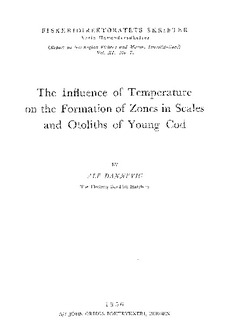| dc.description.abstract | From 27th October 1954 to 23rd February 1955 0-group cod from
the littoral region at Flødevigen were kept in aquaria, and furnished
with running sea-water of different temperatures:
A: The temperature was normal for the season. It varied between
14.3° C at the start, to 2.6° C on 20th February.
In the other experiments the temperatures were lowered within
a few days, and later kept constant:
B: At 4° C.
C: At S° C
D: At 12° C.
The individual length increment varied within wide limits in all
experiments. The cause of the variations may tentatively be ascribed
to different races being involved in the material collected.
The length attained in all experiments (tab. I), was of the same
order as that normally found in nature, and there was no considerable
difference between codlings kept at different temperatures.
At the start in September 1954 the scales showed narrow sclerites
near the margin. A zone was forming. When the codlings were killed
on 23rd February 1955 the scales of the smallest individuals still had
narrow sclerites at the margin - irrespective of temperature. The
medium and large individuals in all experiments except at 12° C
had a wide space of large sclerites. At 12° C the sclerites were small
or moderate, irrespective of quick growth.
We may draw the following conclusions:
a. Narrow sclerites are formed when the sea-temperature is high.
b. Narrow sclerites are also formed at low temperatures i slow-growing
individuals.
c. Wide sclerites are formed at low temperatures in medium and
quick growers.
The results - as to the season of the formation of zones - are
in full conformity with those referred to fromi nature.
It is evident, however, that narrow sclerites cannot be used as an
indication of slow growth of the fish.
There seems to be a chance of correspondence between wide
sclerites and quick growth. But quick growth at relatively high temperatures
may be associated with narrow sclerites.
In slow growers small sclerites will be predominant.
The otoliths were quite normal in cod at winter-temperature and
4° C. There is an opaque centre, and a transparent zone surrounded
by an opaque zone. At 8° C the transparent zone was generally more
diffuse and not so well marked. At 12° C the transparent zone seemed
to proceed more or less diffuse to the margin of the otolith.
This indicates that the transparent zone is formed at relatively
high temperatures, the opaque zone at relatively low. This is in
accordance with the results arrived at by examining young cod from
nature (Dannevig 1933).
Chemical analysis revealed that the formation of organic-opaque
material was highest at 4° C.
The results of the experiments indicate that the formation of zones
in the scales and otoliths of the cod is influenced by temperature
directly or indirectly.
To what degree other factors - food, light or an inherited rhythm
- also come into the probleim will be discussed on the basis of further
experiments. | |
